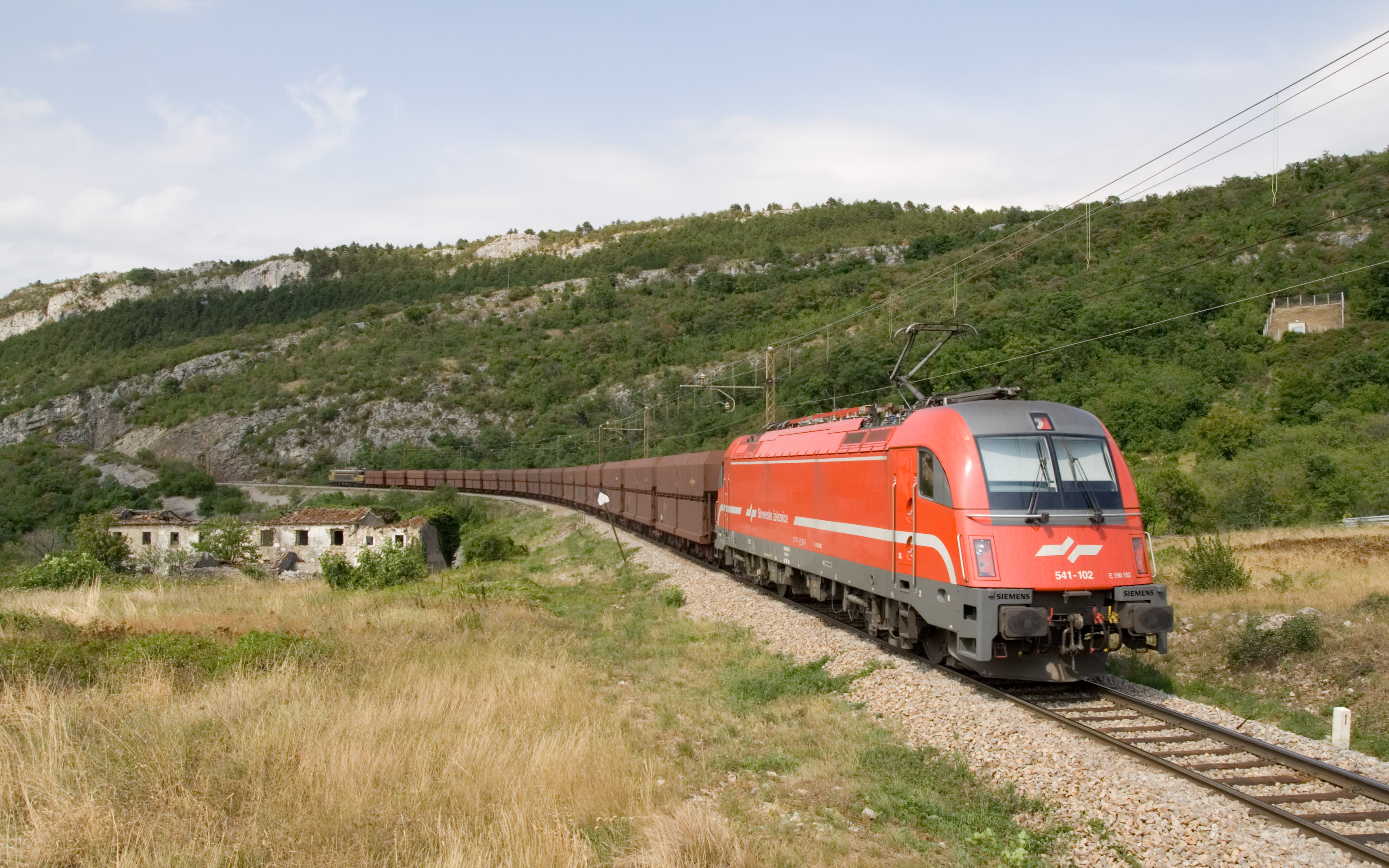|
FS Class 290
The Ferrovie dello Stato Italiane (FS; Italian State Railways) Class 290 (Italian: ''Gruppo 290''), formerly the Rete Adriatica Class 350 bis, is a 0-6-0 steam locomotive. Design and construction The Class 290 was a development of the earlier Class 270 locomotives, studied under the Rete Adriatica; it kept the wheelbase, but replaced the boiler with a slightly bigger one, with a minimally coned rear ring. Its construction was continued under the new FS management, which made it one of its twelve standard designs; it was the last and most successful 0-6-0 Italian locomotive. The class was built by several Italian and foreign manufacturers, between 1899 and 1913. The first 30 locomotives were fitted with a two-axle tender, with a coal capacity of and a water capacity of ; the subsequent ones were fitted with the three-axle tender that would see widespread service under the FS (especially behind the Class 625 and Class 640 locomotives). The first 112 locomotives were classifi ... [...More Info...] [...Related Items...] OR: [Wikipedia] [Google] [Baidu] |
LEW Hennigsdorf
The rail vehicle factory in Hennigsdorf, Germany, was founded in 1910 by AEG. Locomotive production began in 1913, and in the 1930s absorbed the work of the August Borsig locomotive factory, being renamed the Borsig Lokomotiv Werke GmbH until 1944. After the Second World War the factory was nationalised in the German Democratic Republic and produced electric locomotives for home use and for export, mainly to Communist Bloc countries under the name Lokomotivbau-Elektrotechnische Werke (LEW). After German reunification in 1990, the plant returned to AEG ownership, becoming AEG Schienenfahrzeuge GmbH, and then passed through mergers of its parent companies to Adtranz (1996), Bombardier Transportation (2001) and then Alstom (2021). Under Adtranz's ownership production of locomotives ended, and the site now manufactures diesel and electric multiple units. History In 1910 the AEG company acquired a of land in Hennigsdorf near Berlin for the creation of a ceramics factory which b ... [...More Info...] [...Related Items...] OR: [Wikipedia] [Google] [Baidu] |
FS Class 640 II
The Ferrovie dello Stato (FS; Italian State Railways) Class 640 (Italian: ''Gruppo 640)'' is a class of 2-6-0 'Mogul' steam locomotives in Italy. Commonly nicknamed "''Signorine''" (Italian: 'young ladies'), a nickname shared with the similar Class 625, these locomotives were the first superheated steam locomotives in Italy. Design and construction When the FS were created in 1905, Chief Mechanical Engineer Giuseppe Zara undertook a process to design a standard range of locomotives; one of these was the Class 630, a light express engine which, together with the other designs, shared the features of being compound locomotives. However, with the diffusion in Germany (then in close ties with Italy because of the Triple Alliance) of the Schmidt superheater, a decision to build there a batch of 24 non-compound and superheated versions of the Class 630 (keeping all the other features, including the Italian bogie and the peculiar inside-cylinders/outside valve chests and valve gear) wa ... [...More Info...] [...Related Items...] OR: [Wikipedia] [Google] [Baidu] |
Standard Gauge Locomotives Of Italy
Standard may refer to: Symbols * Colours, standards and guidons, kinds of military signs * Standard (emblem), a type of a large symbol or emblem used for identification Norms, conventions or requirements * Standard (metrology), an object that bears a defined relationship to a unit of measure used for calibration of measuring devices * Standard (timber unit), an obsolete measure of timber used in trade * Breed standard (also called bench standard), in animal fancy and animal husbandry * BioCompute Standard, a standard for next generation sequencing * ''De facto'' standard, product or system with market dominance * Gold standard, a monetary system based on gold; also used metaphorically for the best of several options, against which the others are measured * Internet Standard, a specification ratified as an open standard by the Internet Engineering Task Force * Learning standards, standards applied to education content * Standard displacement, a naval term describing the weig ... [...More Info...] [...Related Items...] OR: [Wikipedia] [Google] [Baidu] |
Railway Locomotives Introduced In 1899
Rail transport (also known as train transport) is a means of transport that transfers passengers and goods on wheeled vehicles running on rails, which are incorporated in tracks. In contrast to road transport, where the vehicles run on a prepared flat surface, rail vehicles (rolling stock) are directionally guided by the tracks on which they run. Tracks usually consist of steel rails, installed on sleepers (ties) set in ballast, on which the rolling stock, usually fitted with metal wheels, moves. Other variations are also possible, such as "slab track", in which the rails are fastened to a concrete foundation resting on a prepared subsurface. Rolling stock in a rail transport system generally encounters lower frictional resistance than rubber-tyred road vehicles, so passenger and freight cars (carriages and wagons) can be coupled into longer trains. The operation is carried out by a railway company, providing transport between train stations or freight customer facilit ... [...More Info...] [...Related Items...] OR: [Wikipedia] [Google] [Baidu] |
Pietrarsa Railway Museum
The National Railway Museum of Pietrarsa ( it, Museo Nazionale Ferroviario di Pietrarsa, italic=no) lies beside the Naples–Portici railway, between the city of Naples and the towns of Portici and San Giorgio a Cremano. Pietrarsa is an area among these villages in the past known as “Pietra Bianca” (white stone) but it was renamed Pietrarsa (burnt stone) after the eruption of the Vesuvius in 1631. The museum is housed in what was originally the old Bourbon workshop Officine di Pietrarsa, founded in 1840 at the command of Ferdinand II of Bourbon where steam machines for ships and boilers for locomotives were built. The workshop was organized in pavilions (where the collection is today displayed) which housed the various departments, each specializing in a different part of the production cycle. Overview In 1830, Ferdinand became king of the Kingdom of the two Sicilies. At the beginning, he had a small factory built in Torre Annunziata to produce steam engines for ships an ... [...More Info...] [...Related Items...] OR: [Wikipedia] [Google] [Baidu] |
World War II
World War II or the Second World War, often abbreviated as WWII or WW2, was a world war that lasted from 1939 to 1945. It involved the World War II by country, vast majority of the world's countries—including all of the great powers—forming two opposing military alliances: the Allies of World War II, Allies and the Axis powers. World War II was a total war that directly involved more than 100 million Military personnel, personnel from more than 30 countries. The major participants in the war threw their entire economic, industrial, and scientific capabilities behind the war effort, blurring the distinction between civilian and military resources. Air warfare of World War II, Aircraft played a major role in the conflict, enabling the strategic bombing of population centres and deploying the Atomic bombings of Hiroshima and Nagasaki, only two nuclear weapons ever used in war. World War II was by far the List of wars by death toll, deadliest conflict in hu ... [...More Info...] [...Related Items...] OR: [Wikipedia] [Google] [Baidu] |
Sulmona
Sulmona ( nap, label= Abruzzese, Sulmóne; la, Sulmo; grc, Σουλμῶν, Soulmôn) is a city and ''comune'' of the province of L'Aquila in Abruzzo, Italy. It is located in the Valle Peligna, a plain once occupied by a lake that disappeared in prehistoric times. In the ancient era, it was one of the most important cities of the Paeligni and is known for being the native town of the Roman poet Ovid, of whom there is a bronze statue, located on the town's main road and named after him. History Ancient era Sulmona was one of the principal cities of the Paeligni, an Italic tribe, but no notice of it is found in history before the Roman conquest. A tradition alluded to by Ovid and Silius Italicus, which ascribed its foundation to Solymus, a Phrygian and one of the companions of Aeneas, is evidently a mere etymological fiction. The first mention of Sulmo occurs in the Second Punic War, when its territory was ravaged by Hannibal in 211 BC, who, however, did not attack the ci ... [...More Info...] [...Related Items...] OR: [Wikipedia] [Google] [Baidu] |
Fabriano
Fabriano is a town and ''comune'' of Ancona province in the Italian region of the Marche, at above sea level. It lies in the Esino valley upstream and southwest of Jesi; and east-northeast of Fossato di Vico and east of Gubbio (both in Umbria). Its location on the main highway and rail line from Umbria to the Adriatic make it a mid-sized regional center in the Apennines. Fabriano is the headquarters of the giant appliance maker Indesit (partly owned by Whirlpool). Fabriano, with Roma, Parma, Torino and Carrara, is an Italian creative city (UNESCO). The town is in the category ''Folk Arts'' (for the Fabriano's handmade paper production). History Fabriano appears to have been founded in the early Middle Ages by the inhabitants of a small Roman town south at Attiggio (Latin ''Attidium''), of which some slight remains and inscriptions are extant. Fabriano itself was one of the earliest places in Europe to make high-quality paper on an industrial scale, starting in the 13th centu ... [...More Info...] [...Related Items...] OR: [Wikipedia] [Google] [Baidu] |
Helper Locomotive
A bank engine (United Kingdom/Australia) (colloquially a banker), banking engine, helper engine or pusher engine (North America) is a railway locomotive that temporarily assists a train that requires additional power or traction to climb a gradient (or ''bank''). Helpers/bankers are most commonly found in mountain divisions (called "helper districts" in the United States), where the ruling grade may demand the use of substantially greater motive power than that required for other grades within the division. Historic practice Helpers/bankers were most widely used during the age of steam, especially in the American West, where significant grades are common and trains are long. The development of advanced braking systems and diesel-electric or electric locomotives has eliminated the everyday need for bankers/helpers in all but a few locations. With the advent of dynamic brakes on electric or diesel-electric locomotives, helpers/bankers can also be used to provide more braking f ... [...More Info...] [...Related Items...] OR: [Wikipedia] [Google] [Baidu] |
FS Class 625
The Ferrovie dello Stato (FS, Italian State Railways) Class 625 ( it, Gruppo 625) is a class of 2-6-0 'mogul' steam locomotives in Italy. The class is commonly known by the nickname ''Signorine'' (Italian for 'young ladies', also shared with the similar Class 640 locomotives), or ''Signorina'' in the singular, because of their perceived grace and beauty compared to other locomotives. Design and construction The Class 625 was the superheated and simple-expansion version of the pre-existing mixed traffic Class 600 design. Following the success of the Class 640 (itself a superheated and simple-expansion version of the older Class 630 engines) previous designs were altered accordingly, and 108 of the class were built by various companies in Italy between 1910 and 1914, with a further 80 constructed between 1922 and 1923, the last 25 by Berliner Maschinenbau; the gap in the production run was caused by the events of World War I. Class 625 3xx conversions From 1929 onwards the exist ... [...More Info...] [...Related Items...] OR: [Wikipedia] [Google] [Baidu] |




